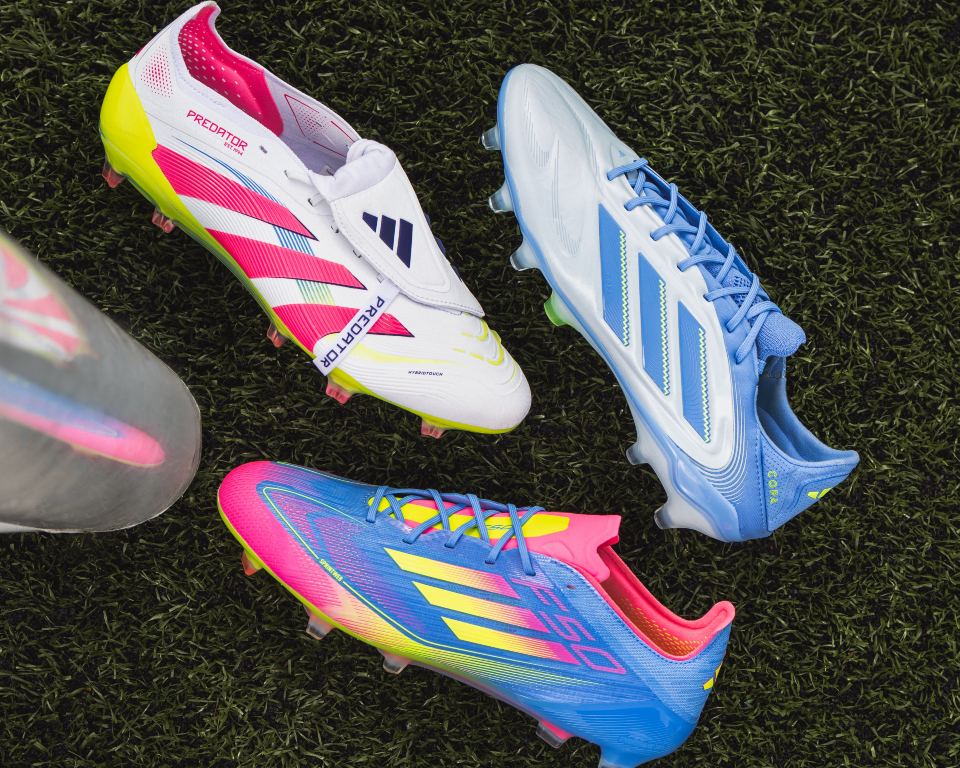For over three decades, the adidas Predator has shaped the evolution of football boots—transforming the role of technology in modern gameplay.
Known for their standout design and technical edge, Predator boots have been worn by some of football’s biggest names.
With a foundation built on power, precision, and forward-thinking design, adidas continues to lead the charge in the 2024/25 season.
Join us as we explore the early days of the Predator and see how each model shaped its evolution.
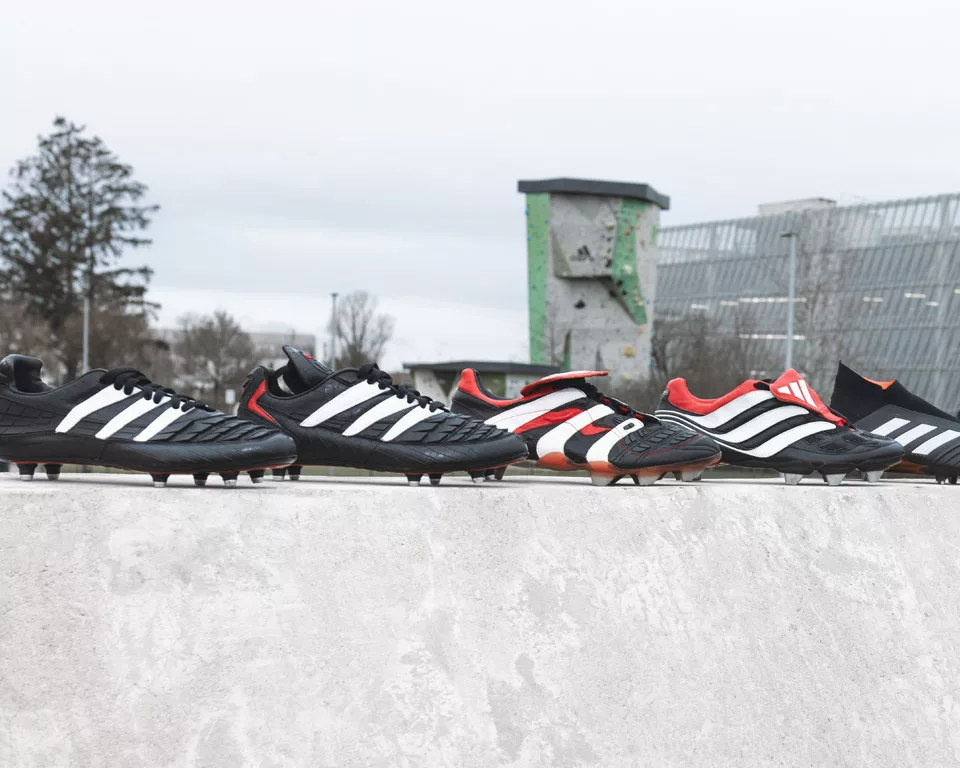
’94 – The adidas Predator
Making its debut at the 1994 World Cup, the adidas Predator showcased a potential few could have predicted, soon becoming an icon that would leave a lasting mark on the footballing world.
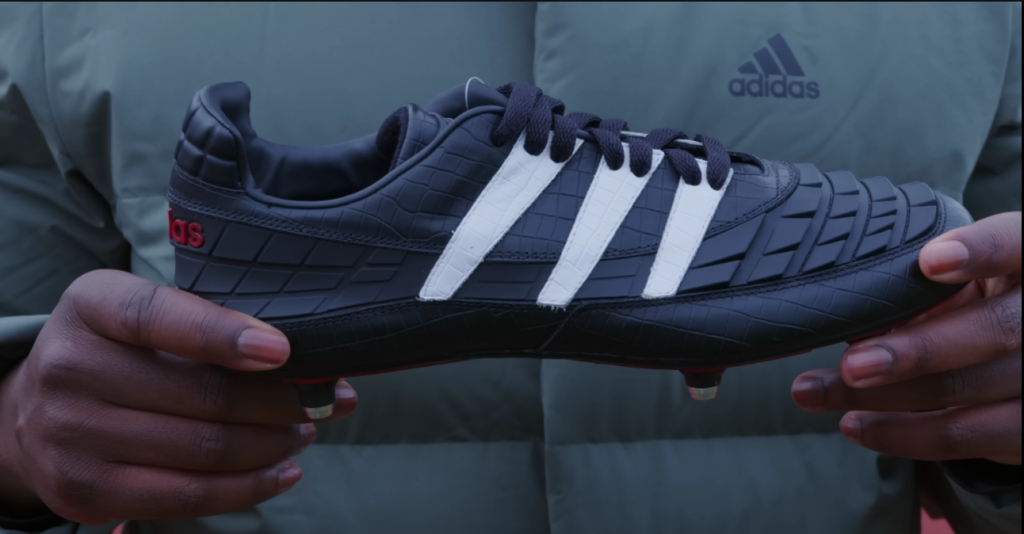
Wearing the instantly recognisable Black, White, and Red colourway, Celtic’s star midfielder John Collins first demonstrated the Predator’s potential.
His stunning free-kick against Rangers at Ibrox Stadium marked a turning point—not just for Collins, but for the Predator brand, establishing it as the boot for unforgettable moments
Where it all began: Craig Johnston
Inspired by the spin and control of a table tennis paddle, Craig Johnston designed the first adidas Predator, complete with raised rubber elements that revolutionised boot design and changed how players interacted with the ball.

Engineered to deliver exceptional power and accuracy with every shot, Johnston’s dedication to his craft paved the way for players to master techniques such as the Straight Curl and classic Chip Shot with greater ease than ever before.
Complete with a kangaroo leather upper—a material adidas is now phasing out due to sustainability concerns—the Predator provided a durable yet soft and comfortable fit in a compact form.
Fun Fact: The Predator weighed a staggering 391 grams– Significantly heavier than the current Predator FT ’24 that sits at a much lighter 215g.
’95 -The Predator Rapier
In a nod to the Predator’s acceptance as a silo set to stay, adidas followed the original Predator boot with the notorious Predator Rapier in 1995.
Sporting essentially the same design as the 1994 original Predator, the Rapier for ’95 provided players with the addition of a fold-over tongue to make placing the boots on feet much easier, whilst delivering a ‘close to the ball’ feel.
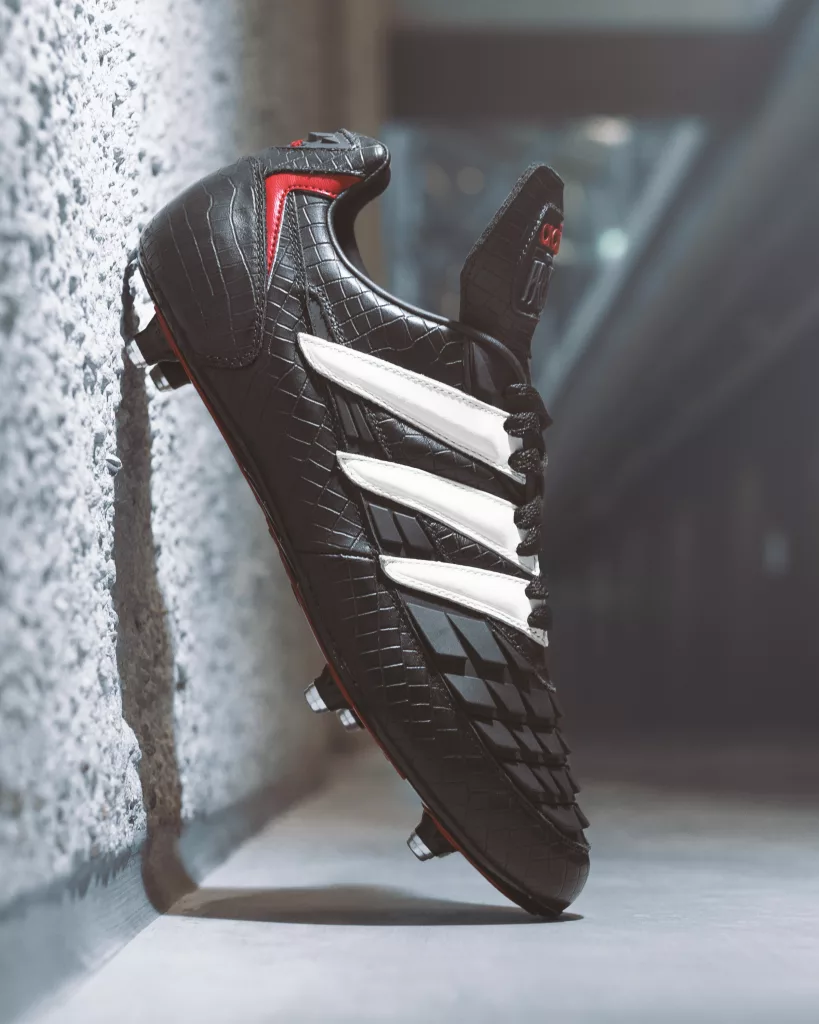
The most exciting aspect of the ’95 Rapier?
It was the first football boot to offer its players a range of different colourways, with the addition of a limited edition white colourway.
Fun Fact: If it weren’t for the Rapier, adidas would not have kickstarted colourful colourways and football pitches wouldn’t be as vibrant or dynamic as they are today.
’96 The Predator Touch
Two years after its inception into the sporting world, adidas continued to refine and tweak the praiseworthy Predator, and gave rise to the Predator Touch in 1996.
Little did anyone know that the silo that would soon kickstart the career of none other than David Beckham.
Having heard rave reviews from fellow players, Beckham requested a pair just in time for the opening fixture against Wimbledon.
The result?
adidas had only one Size 8 boot available set aside for Ranger‘s Charlie Miller, and even had his name embroidered onto the tongue.
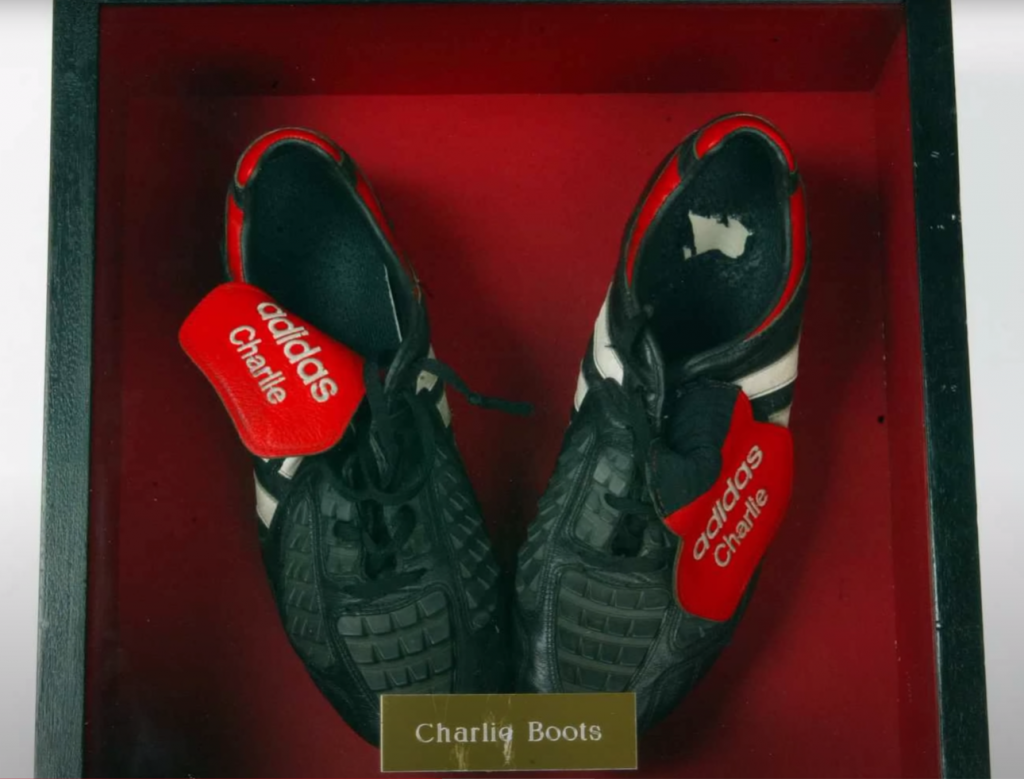
Beckham got some stick for this in the dressing room, but it didn’t stop the Midfielder from securing one of the best goals in Premier League history, as he plotted the ball into the back of the net from the halfway line to kickstart his journey with the Predator.
It was here Beckham and the Predator became one of the most iconic duos that the football world had ever seen.
’98 The Predator Accelerator
In 1998, adidas introduced the Predator Accelerator, refining the design with an all-new Traxion soleplate, bladed studs, and an updated asymmetrical lacing system for a larger, more precise striking zone.
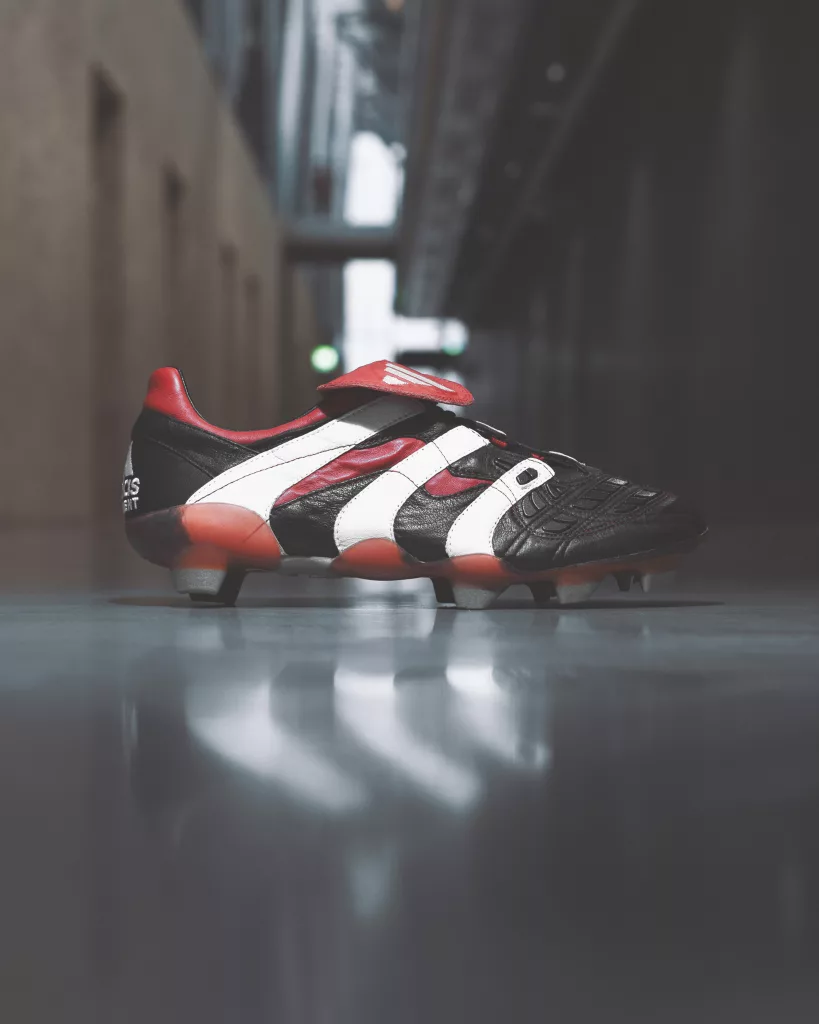
The rubberized elements from its predecessor, the Predator Touch, were significantly reduced, resulting in a more streamlined and uniform silhouette.
adidas’ signature three stripes dominated the boot’s landscape, forming a wraparound design that remains one of the most iconic looks to grace the world stage.
’00- The Predator Precision
Who could forget the Predator Precision—the boot that powered David Beckham’s iconic free-kick against Greece, securing England’s spot in the 2002 World Cup and forever cementing its place in history?
Never before had a boot so rightly lived up to its name . ‘Precision’ at its finest.
Sporting a larger tongue with Velcro, adidas ensured the contact zone provided a much sought-after close-to-the-ball feel with every strike. Though the Velcro’s durability was a drawback, the boot’s iconic legacy more than makes up for it.
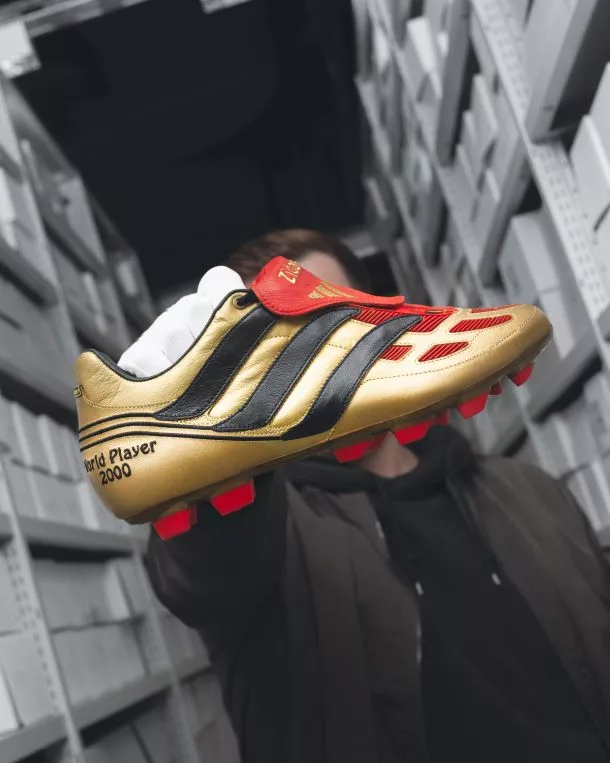
Fun Fact: The Predator Precision became the first predator to feature interchangeable Traxion studs, allowing players to tailor their game based on pitch conditions and positions they played.
’02 – Predator Mania
Arguably the most recognisable boot in the Predator series and making the cut in our list of the Top 10 adidas Football Boots of All Time – the 2002 Predator Mania was a sight to behold.
Delivering a much larger fold-over tongue than the pred’s predecessors, the Mania provided players with greater coverage of the laces and utilised a rubberised band to keep the tongue in place (A significant improvement over the Velcro used for the Precision boot!)

The rubberized elements again became an area of focus, where this time they were designed to only cover the inside of the forefoot, with the signature three stripes again placed to the outsole.
Featuring a split soleplate, adidas looked to reduce the weight of the boot, bringing it down to 325g, a significant 17% weight reduction since the release of their first Predator, making the boot the lightest of its day!
Not only this, but the addition of a new heel counter supported the ankle and helped Zidane score one of the greatest Champion League goals of all time- a sensational volley against Bayer Leverkusenin at the 2002 UCL Final.
’04 – Predator Pulse
Following the launch of the adidas Predator Mania—widely regarded as one of the greatest football boots of all time—adidas faced the challenge of creating a worthy successor. That boot was the Predator Pulse.
Featuring a clever new innovation called PowerPulse, the Pulse shifted 40 grams of weight toward the front of the boot using a specially engineered sock-liner.

By moving the centre of gravity closer to the point of impact, it enhanced power transfer and increased the force of each strike by 3%.
While it may not sound like a lot, this boot tech revamp assisted some of the best midfielders in the world of the time, including Beckham, Gerrard and Ballack.
Fun Fact: These boots were not only worn by David Beckham, Steven Gerrard and Michael Ballack back in the 04/05 season, but also helped Deco earn Man of the Match in the 2004 UEFA Champions League Final, as Porto cruised past AS Monaco with a 3-0 victory.
’06 – Predator Absolute
After redefining power and control with the Mania and Pulse, adidas introduced the Predator Absolute in 2006 — a model that shifted focus toward personalised performance ahead of the World Cup in Germany.
Central to that shift was PowerPulse 2.0 — a removable sockliner system that allowed players to choose between a heavier or lighter setup at the forefoot. More weight meant greater impact through the strike zone, while the lighter option offered a more responsive feel across the pitch.

Visually, the boot kept familiar Predator DNA, with off-centre lacing and a return of the fold-over tongue, now secured with Velcro and shaped with a cleaner profile. Across the upper, repositioned rubber fins gave players more grip and curl when shaping passes or free kicks — particularly useful for dead-ball specialists.
The boot featured heavily at the 2006 World Cup. Zinédine Zidane wore the Absolute in gold throughout his final tournament, including the now-legendary Panenka penalty in the final.
David Beckham delivered from set-pieces in the white-and-gold edition, while Del Piero, Kaká, and Vieira all took to the pitch in variations of the silo, helping cement its place in Predator history..
Fun Fact: The Predator Absolute came in 4 distinct colourways since its inception, the most popular of these being the gold-and-white edition that were associated with Zidane’s swansong – including his infamous headbutt which unintentionally made the boot part of footballing folklore.
07/08′ – Predator Powerswerve
Launched in late 2007, the Predator Powerswerve marked the end of what many consider the golden era of leather Predators, just before adidas began shifting towards synthetic-focused designs.
The PowerPulse weight chamber returned — now fixed in place and packed with tungsten-filled elements, increasing the mass behind each strike by up to 40%. Unlike its predecessor, the sockliner was no longer removable, but the added punch through the forefoot was hard to ignore.

Elsewhere, the soleplate was overhauled for improved torsional stability, giving players a more planted base to strike from. Across the upper, SmartFoam fins adapted on contact — helping deliver extra friction and responsiveness when shaping curl or powering shots.
The Powerswerve quickly became a go-to heading into Euro 2008 and beyond. David Beckham wore them for LA Galaxy and England, including his 100th England cap in 2008. Steven Gerrard favoured them for Liverpool’s European campaigns, where their balance and feel played into his long-range passing game.
The boot even crossed into rugby, with Jonny Wilkinson opting for a modified pair during his time with England — a rare crossover that underlined the Powerswerve’s reputation as a strike-first Predator.
09′ – Predator X
For the first time in the Predator series, adidas dropped their signature kangaroo leather upper in favour of a synthetic material called Taurus with the launch of the Predator X.
This move aimed to reduce weight and modernise the Predator’s feel — but it came at a cost. The iconic fold-over tongue was gone, and many fans missed the natural softness and fit that had defined earlier models.
In its place came a sleeker one-piece upper with a central lacing system — a clean break from Predator tradition, both visually and in performance.
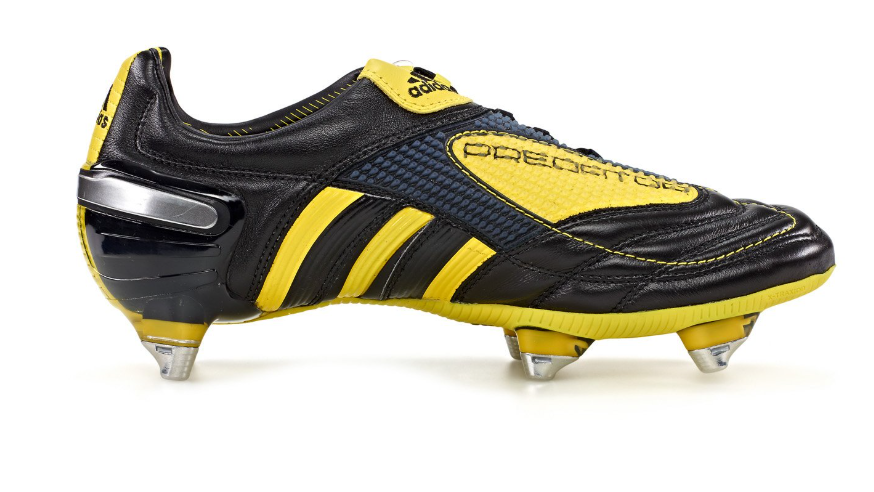
Rather than bringing back the rubber fins of past boots, the X introduced a larger, integrated Predator zone made from SL rubber, which was meant to enhance power and swerve. In reality, many felt it lacked the sharpness of earlier versions.
Where the Predator X found its edge was underneath — in the new Powerspine chassis embedded within the soleplate. A stiffened insert helped limit flex on striking, improving energy transfer through the ball and boosting shot power without sacrificing stability.
While its design divided opinion, the Predator X still featured heavily on pitch. Steven Gerrard wore them consistently for Liverpool and England, while Michael Ballack, Robin van Persie, and Xabi Alonso all transitioned from the Powerswerve to the X during this new chapter of Predator evolution.
’11 – Predator Adipower
When adidas introduced the Predator adiPower in 2011, it struck a rare balance — embracing lightweight innovation without losing the aggressive identity that had defined the Predator line.
As the last Predator to feature any leather, its legacy was brief but memorable. Just a year later, adidas went fully synthetic with the Predator LZ (more on that soon), but the adiPower left its mark as a transitional icon.
Borrowing tech from the F50 adiZero, the adiPower ditched the bulkier Traxion outsole of the Predator X in favour of a SprintFrame plate. The result was a significant drop in weight and a sharper, more responsive feel underfoot — perfect for quick cuts, fast recoveries, and explosive strikes.

Up top, adidas blended heritage with forward-thinking design. The forefoot featured premium Taurus leather, delivering a soft, cushioned touch, while the midfoot and heel used a lightweight synthetic microfibre to improve structure and reduce water absorption — crucial when conditions turned against you.
The rubber grip elements evolved too. Now split into PowerZone (for striking) and SwerveZone (for curl), the layout was more aggressive, with thinner, more flexible fins placed with greater precision than the chunkier designs of the early 2000s.
Favoured by the likes of Robin van Persie, Xavi, and Nani, the adiPower helped usher in a new wave of attacking midfielders and forwards — a boot just as comfortable winning the ball in midfield as it was bending it into the top corner.
’12 – Predator LZ
With the release of the Predator LZ in 2012, adidas made a bold departure from Predator tradition. Gone were the fold-over tongue, the rubber fins, and the leather upper — in their place came a new formula built entirely around zones. Five of them, to be exact.
The Predator LZ — short for Lethal Zones — introduced a lightweight HybridTouch synthetic upper, with five distinct contact areas built into the boot’s design to enhance control, passing, and striking.

Each zone served a purpose: the Drive Zone across the laces for hitting through the ball, the First Touch Zone on the forefoot to kill pace on impact, the Sweet Spot on the instep for curl, the Dribble Zone on the outer toe for close control, and the Pass Zone through the medial side for improved distribution.
It was a complete rework of the Predator identity — one focused less on raw power and more on technical precision.
Beneath, the LZ featured a SprintFrame soleplate, borrowed from the F50 adiZero, helping bring the weight down to just under 230g — the lightest Predator to date at the time.
Worn by Xavi, Van Persie, Di María, and Mesut Özil during EURO 2012, the LZ reshaped the Predator for a new generation of midfield technicians. It didn’t look like the Predator boots that came before it — but for a wave of control-first players, it didn’t need to.
’13 – Predator LZ II
In 2013, adidas refined the Predator LZ concept with the release of the Predator LZ II. While maintaining the five-zone configuration, the LZ II introduced reengineered rubber elements, each featuring unique textures and patterns to enhance ball interaction.

The HybridTouch synthetic upper remained, offering a soft, leather-like feel with improved flexibility. The Traxion 2.0 stud configuration provided reliable traction on firm ground surfaces.
The LZ II was worn by players like Mesut Özil, Xabi Alonso, and Juan Mata, and was notably featured in the Ray Green launch colourway.
’14 – Predator Instinct
To mark 20 years since the original Predator, adidas dropped the Predator Instinct in 2014 — a more structured, aggressive boot that moved away from the lighter LZ models and nodded back to classic power boots like the Powerswerve and Accelerator.
The HybridTouch synthetic upper aimed to replicate leather’s natural feel, while SL rubber zones were reworked across key contact areas. From the Drive Zone on the instep to boost striking power, to the Dribble and First Touch Zones, the Instinct gave players more grip and control without overcomplicating things.

Beneath, a new ControlFrame soleplate improved flexibility through the forefoot while keeping traction sharp on firm ground.
At around 277g, the Instinct carried more weight than its predecessors, but stayed true to the Predator’s roots. The fit was snug through the midfoot, and with minimal stretch in the upper, sizing needed to be spot on.
’17 – The Predator 18
Following on from a 3-year hiatus, the Predator made its return at the end of 2017 to give us the “18+” – the first laceless Predator and one to feature a super-soft PRIMEKNIT upper with a control skin that provided excellent grip.
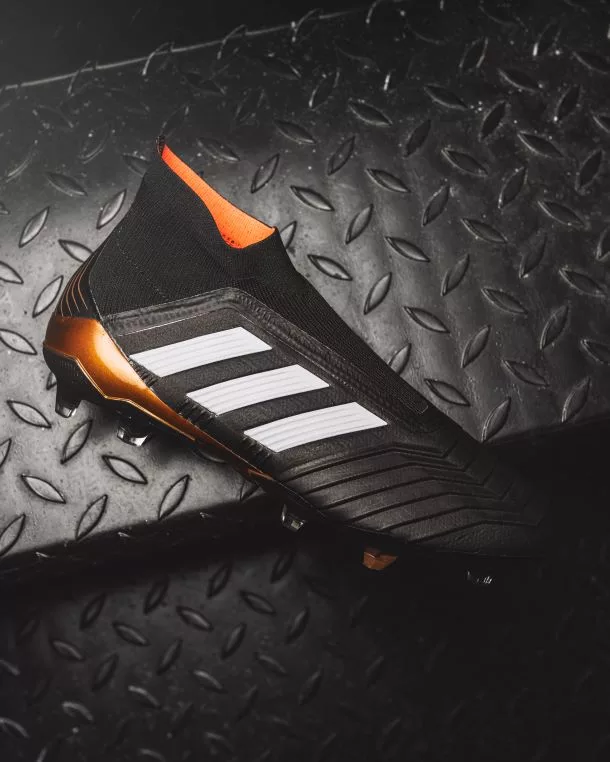
The classic rubber elements?
These came to be replaced with intricate ridges across the toe box to provide better contact with the ball, whilst a flexible stretchy sock-fit collar enabled a more locked-in feel.
adidas Predator 18+ Playtest
’19 – Predator 19
Building on the foundations laid by the Predator 18, the Predator 19+ refined adidas’ vision of a modern Predator — laceless, lightweight, and reengineered for total control. It kept the Primeknit upper and Controlskin grip zones, but introduced subtle upgrades for a more adaptive fit and responsive feel.
The Forged Knit midfoot added extra structure without sacrificing flexibility, while tweaks to the sock-fit collar improved lockdown and ease of entry. The laceless design stayed firmly in place, giving players a seamless striking surface that mirrored the boot’s minimalist aesthetic.

Worn on some of football’s biggest stages throughout 2019 and into early 2020, the Predator 19+ was trusted by elite players like Paul Pogba, Dele Alli, Ivan Rakitić, Mesut Özil, and Marcelo Brozović.
Pogba’s Champions League edition in particular stood out — a bold, expressive design that echoed his unique playing style and creativity on the ball.
While it didn’t reinvent the wheel, the Predator 19 showed how far the silo had come from its power-heavy past — and how adidas was doubling down on redefining control for a new era.
’20 – The Predator Mutator
After a mixed journey for the Predator, with many revisions made to the boot, in particular concerning the boot’s tongue, lace placement, adjustment of rubberized elements and incorporation of a split soleplate, the Predator Mutator made one of the boldest statements of all.
The rubber elements that the Predator was known for were back and in an entirely new way.
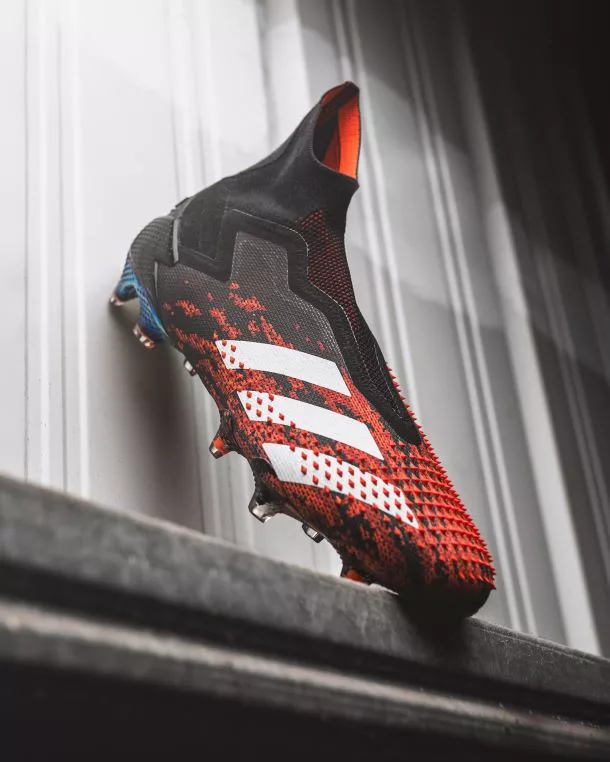
Showcasing 406 refined miniature spikes across the forefoot of a Demonskin upper, adidas spiced things up with their design for this particular year and even offered players the opportunity to choose from either High or Low-Cut versions for the first time.
The high-cut version in particular, offered an exclusive signature PRIMEKNIT collar for exceptional lockdown.
adidas Predator Mutator 20+ Playtest
’21 – Predator Freak
If the Predator Mutator was a bold return to form, the Predator Freak was its natural evolution — louder, sharper, and unapologetically aggressive.
Building on the Demonskin technology introduced the year before, adidas refined the concept with Demonskin 2.0, now featuring a re-engineered layout of over 400 rubber spikes positioned with even greater precision across the upper.
The goal? Maximise grip and swerve — giving players more control on contact and even greater whip on strikes.

Visually, the Freak was impossible to ignore. Its split sock collar brought a dramatic, claw-like aesthetic while improving comfort and ankle mobility. The upper used Primeknit throughout for a lightweight, adaptive fit, available in both the laceless Freak+ and traditional laced Freak.1 versions.
The Predator Freak appealed to expressive, unpredictable players who played on instinct and control — shifting momentum in tight spaces and dictating the pace in possession.
Paul Pogba remained the face of the silo, frequently spotted in his own signature editions throughout the 2020/21 season. He was joined by David Alaba, Marcelo Brozović, and Wendie Renard, with the boot also seen throughout EURO 2020.
For some, the Freak was too extreme. For others, it was the clearest expression yet of what the Predator had become — direct, aggressive, and unafraid to take risks.
’22- Predator Edge
Seeing the spikes removed and replaced with something more fine-tuned to the Predator of old with a lowered collar, the Edge’s colourway takes influence from the 2012 Predator LZ.
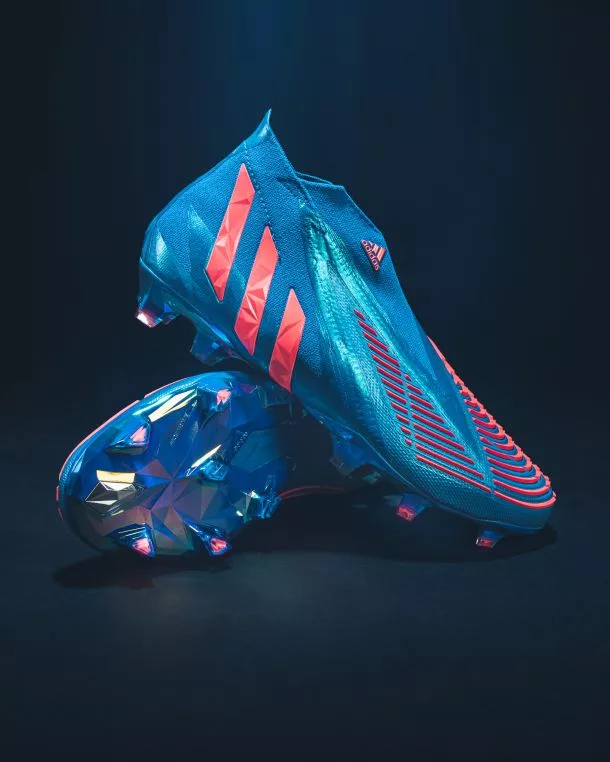
A power Facet in the tip of the sole gives more power with every swing, much like the 2006 Predator absolute with its signature POWER PULSE technology.
adidas Predator Edge Playtest
’23 Predator Accuracy
Drawing inspiration from the rubber grip elements featured in iconic models like the Predator Mutator and Edge, the Predator Accuracy incorporated these rubber components and strategically placed across the key strike zones, creating what adidas proudly dubs a “High-Definition” grip structure.
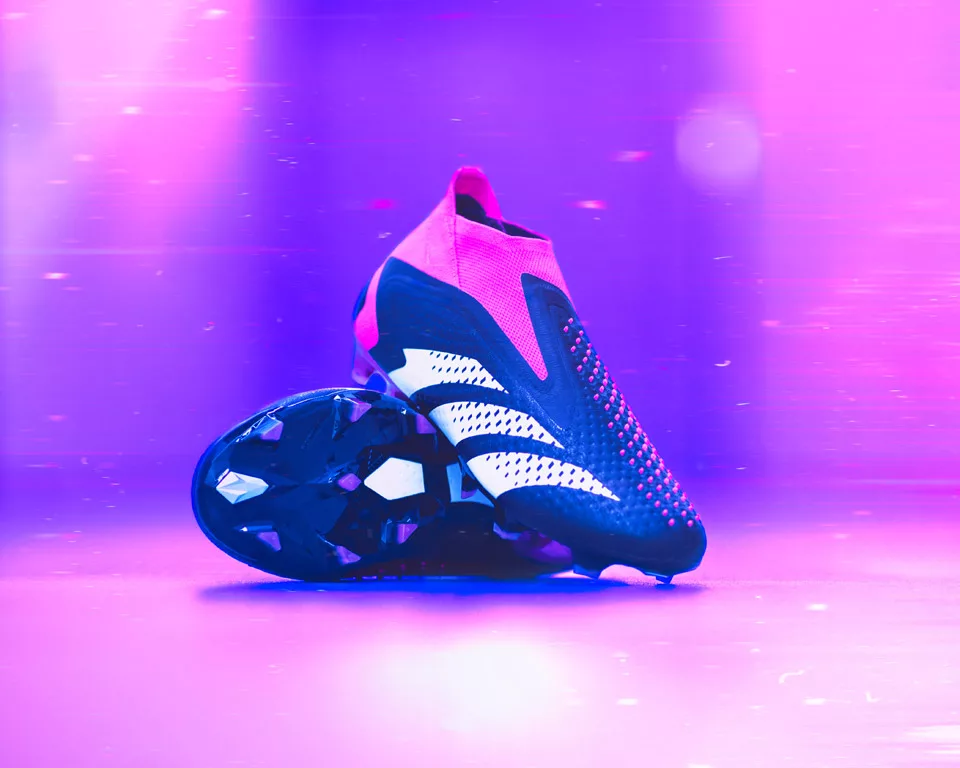
The Accuracy took cues from the ’98 World Cup Predator and the 2000 Precision, merging heritage-inspired visuals with updated tech.
Enhancing both form and function, the boot boasts a two-piece Primeknit collar for ultimate comfort and support. Additionally, a cleverly designed metal Power Facet near the forefoot’s tip redistributes weight towards the front, providing an extra punch when striking the ball.
And when it comes to personalization, the Predator Accuracy offers a plethora of colorways to cater to every taste, ranging from vibrant pinks and oranges to refreshing greens.
Multiple colourways were introduced, ranging from bold pinks to clean greens — allowing players to match performance with personality
adidas Predator Accuracy Playtest
’24 – adidas Predator 24
Celebrating 30 years since the original Predator, adidas delivered the Predator ’24—a highlight of the reboot era.
With a black base and vibrant pops of orange and electric yellow accents, the Predator ’24 harkens back to the 90s.
Featuring a traditional fold-over tongue to enhance the strike zone, the Hybrid Touch 2.0 upper is softer, thinner, and less padded than previous models, providing an optimal feel for the ball.
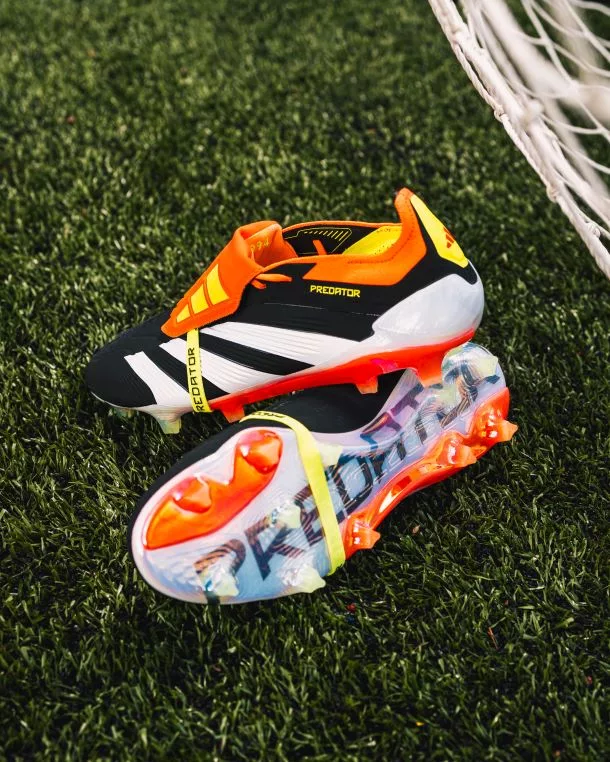
The redesigned rubber fins optimise grip and spin with every touch, while the revamped Control Frame 2.0 soleplate, with triangular studs and bars in the center, enhances stability and responsiveness.
As one of the sleekest and fastest selling Predator football boots in years, it’s safe to say that adi are back on top.
adidas Predator ’24 Playtest
’25 – adidas Predator 25
adidas caught us off guard early in December 2024 with the debut of the adidas Predator 2025, a boot launched ahead of the new year as the next evolution in the series.
Dubbed the “Champagne Pred,” adidas combined the 90s-inspired flair of the Predator 24 with design cues from the Predator Edge “Showdown,” refining it with textured contours and a sharper silhouette shaped for attacking play.
But aesthetics aside, what’s changed under the hood?

adidas has enhanced the grip zones across the upper, adding more contoured elements than its predecessor for better ball control in tight spaces.
The soleplate also sees an upgrade, with the Facetframe tooling replacing ControlFrame 2.0. This adjustment places a Power Facet in the forefoot, shifting weight forward for optimal power transfer, ensuring every strike carries more venom and precision.
Currently worn by the likes of Bellingham, Trossard, Russo, and Clinton, the Predator 25 is built for goal hunters—a fusion of Predator DNA with the latest in adidas innovation.
We’ll be back!
We’re thrilled to see how adidas will push the Predator even further in 2025. Stay tuned for exclusive updates—we’ll be ready to share as soon as the next chapter begins.
In the meantime, explore the latest adidas Celestial Victory Predator, now available at Lovell Soccer, and experience the evolution for yourself!
